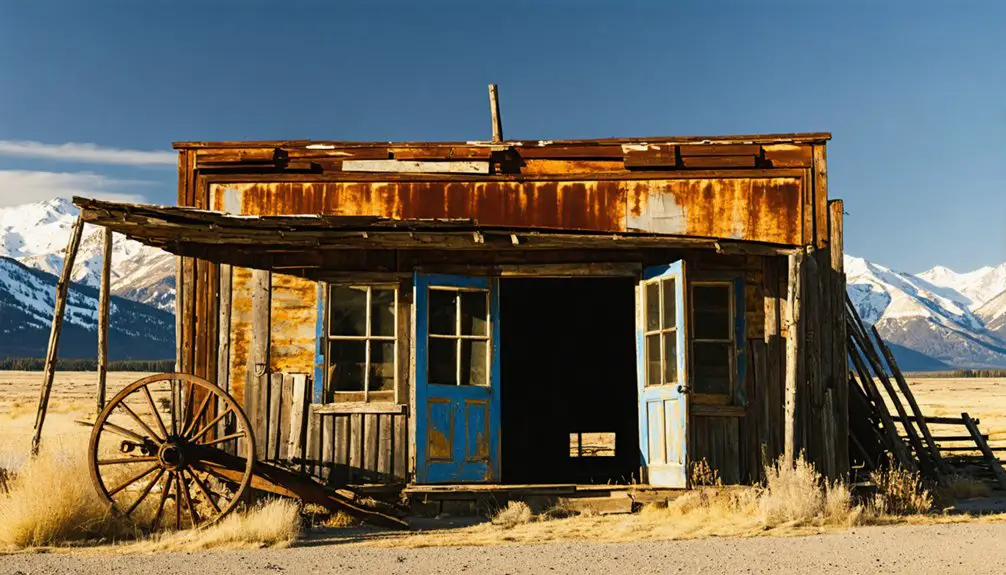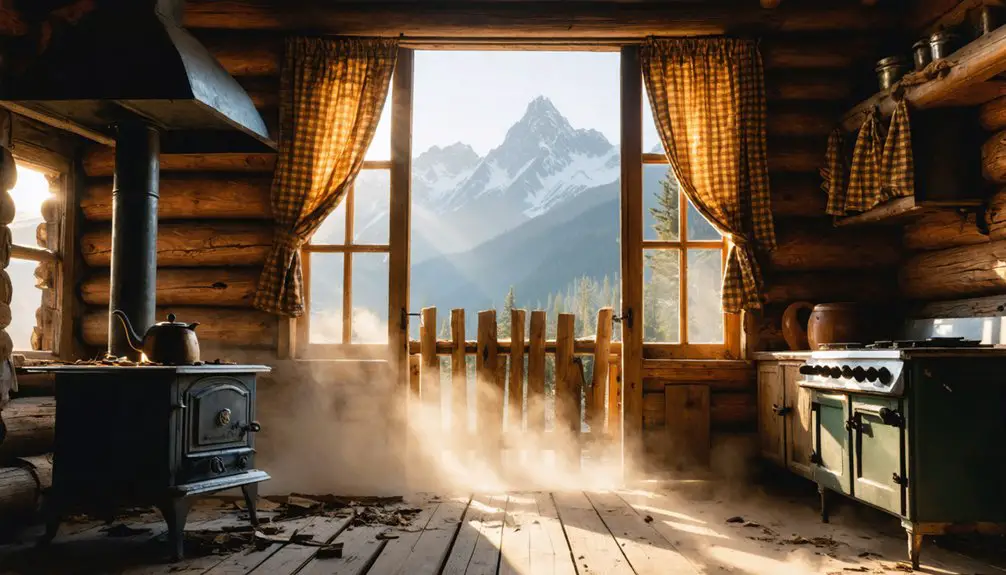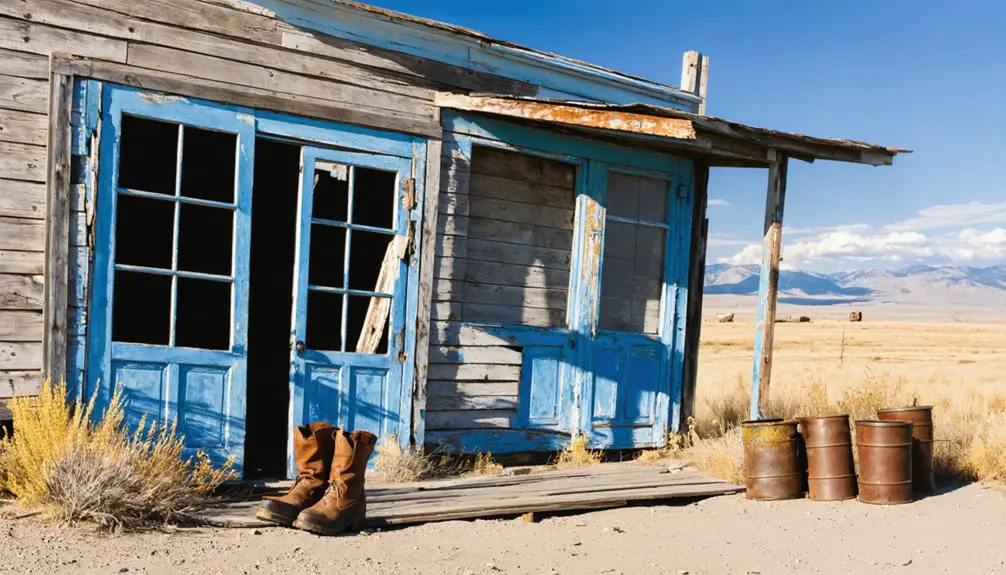Madison County’s ghost towns offer you a remarkable window into Montana’s 1860s gold rush era. You’ll find over 60 preserved structures in Bannack, while Virginia City, the former territorial capital, features authentic 19th-century architecture and living history demonstrations. Nevada City’s 108 gold rush buildings, along with hidden gems like Red Bluff and Ruby, showcase frontier life and mining heritage. Summer brings vibrant reenactments, while off-season months reveal peaceful exploration opportunities.
Key Takeaways
- Virginia City and Nevada City offer the most accessible and well-preserved ghost towns, featuring over 100 authentic gold rush-era buildings.
- Bannack preserves more than 60 historic structures and hosts annual Bannack Days with period demonstrations in July.
- Red Bluff and Ruby ghost towns showcase original mining equipment and frontier buildings in the Tobacco Root Mountains.
- Summer months provide optimal exploration conditions with guided tours, historical reenactments, and cultural events across Madison County.
- The Montana Heritage Commission maintains extensive artifact collections and offers educational programs about the region’s mining history.
The Mining Legacy of Madison County’s Ghost Towns
When gold was discovered in Madison County during the early 1860s, it sparked a dramatic transformation of Montana’s landscape as mining towns rapidly emerged throughout the region.
You’ll find that early Mining Techniques began with placer mining in streambeds, but soon evolved into more complex lode mining operations targeting rich veins of gold, silver, lead, and zinc embedded in quartz.
Towns like Bannack and Pony flourished as mining centers, with some veins reaching depths of 14 feet. Inside Bannack’s preserved buildings, over sixty structures still stand as testament to the town’s golden era.
The Economic Impact rippled through the territory as these towns grew into bustling hubs.
You’ll discover how mining wealth funded Montana’s first territorial capital and supported diverse communities with saloons, stores, and stagecoach routes.
Millions of dollars worth of precious ores extracted from these mines fueled the region’s rapid development.
When resources depleted, these once-thriving towns faced rapid decline, leaving behind the ghost towns you can explore today.
Virginia City: A Living Historical Monument
Virginia City stands as Montana’s crown jewel of living history, earning its designation as a National Historic Landmark. As the territorial capital in 1865, it grew to 5,000 residents during the gold rush, becoming the region’s largest settlement.
Through meticulous historical preservation, you’ll discover authentic 19th-century architecture, including the Gothic-styled Grace Methodist Episcopal Church from 1875. The town’s original buildings now serve as museums, shops, and event venues while maintaining their frontier-era character. The discovery of placer gold deposits in Alder Gulch sparked the richest strike in Rocky Mountain history. Dedicated preservation crews work tirelessly to maintain historic structures using traditional craftsmanship techniques.
Your cultural immersion experiences include stagecoach rides, firetruck tours, and interactions with living history interpreters in period attire.
Visit between Memorial Day and Labor Day when you can pan for gold, explore the boardwalk, and witness blacksmithing demonstrations.
Don’t miss nearby Nevada City, just a mile away, for an extended historical adventure.
Nevada City’s Gold Rush Heritage
Just a mile down the road from Virginia City, Nevada City emerged as another vibrant hub of Montana’s gold rush era. When Bill Fairweather and Henry Edgar discovered gold in Alder Gulch in 1863, you would’ve witnessed thousands of fortune seekers flooding the area.
Due to the various locations sharing the name Nevada City, historians often specify this site as Montana’s Nevada City to avoid confusion.
By 1864, nearly 10,000 miners transformed the gulch into the “Fourteen-mile City” mining corridor.
Like a river of humanity, thousands of gold-seekers carved out a bustling fourteen-mile stretch of mining settlements along Alder Gulch.
At its peak, Nevada City boasted six blocks of businesses, including stores, a brewery, and a Masonic hall. The area’s cultural significance stems from the incredible $30-40 million in gold extracted during the first five years alone.
While the population dwindled by 1876, you can now explore this preserved slice of history thanks to Charles Bovey’s 1950s restoration. Visitors can enjoy the largest music collection of automated machines in North America at the Nevada City Music Hall.
Today, you’ll find 108 gold rush era buildings, including 14 original structures, bringing the past to life through living history demonstrations.
Hidden Gems: Red Bluff and Ruby Ghost Towns
If you’re seeking Montana’s less-traveled ghost towns, you’ll find Red Bluff and Ruby packed with visible remnants of their 1860s mining heritage.
You can explore Red Bluff’s stone schoolhouse and Tanners Hotel ruins along Highway 84, while Ruby’s surviving buildings and mining equipment paint a vivid picture of frontier life.
These remote sites offer authentic glimpses into Montana’s mining past, with scattered artifacts and foundations telling stories of boom-and-bust cycles that shaped the American West. Located in the Tobacco Root Mountains, Red Bluff’s historic mines were instrumental in establishing the town’s early prosperity. Similar to Virginia City’s preservation, these ghost towns provide valuable insights into early Montana settlement.
Mining Heritage Still Visible
When exploring Montana’s mining heritage, two lesser-known ghost towns stand as remarkable symbols to the state’s gold rush era: Red Bluff and Ruby.
You’ll find Red Bluff about 34 miles west of Bozeman on Highway 84, where mining artifacts and structural remnants tell the story of a once-thriving community of 500 residents. The stone ruins of Tanners Hotel and the old school building offer glimpses into life during the 1860s gold rush. Students in Dr. Burlingame’s classes documented these historical sites through detailed research papers.
For ghost town exploration further south, Ruby reveals its mining heritage through remains of the Montana Mine near Montana Peak. This area, like many other mining districts in Madison County, produced valuable deposits of gold, silver, copper, and lead.
Originally called Montana Camp in the 1870s, this site showcases how mining camps evolved from basic tents to established communities. You can still trace the mining history through scattered remnants along county roads and throughout the Oro Blanco Mining District.
Remote Adventures Worth Taking
For adventurous history buffs seeking authentic ghost town experiences, Red Bluff and Ruby stand as Montana’s hidden treasures worth exploring.
You’ll find Red Bluff’s remnants about 34 miles west of Bozeman along Highway 84, where ghost town exploration reveals the old Tanners Hotel, stone ruins of the school, and scattered mining equipment. The nearby Red Bluff-Norris Cemetery adds to the historic atmosphere.
Head deeper into Madison County to discover Ruby’s stone buildings and mining relics.
Both sites offer pristine examples of mining site preservation, letting you step back to the 1800s gold rush era. You can hike or drive off-road to view abandoned dredging equipment and placer mining piles against the backdrop of the Tobacco Root Mountains, all while experiencing the untouched solitude that makes these remote destinations so compelling.
Planning Your Ghost Town Adventure

Anyone planning to explore Montana’s ghost towns needs careful preparation to guarantee a safe and rewarding adventure.
Start by checking road accessibility and seasonal conditions, as some sites like Independence require high-clearance vehicles. You’ll find Norris easily accessible via US Route 287, while other locations may need more planning.
Research access roads and seasons before visiting – some ghost towns demand rugged vehicles, while others offer simpler routes.
Remember to respect visitor regulations and obtain necessary permits. Bannack charges $8 per vehicle for non-residents, while Garnet costs $3 per person.
Pack essential gear including maps, sturdy footwear, and emergency supplies, as cell coverage is limited. Bring plenty of water and dress in layers, especially at higher elevations like Garnet at 6,000 feet.
For safety, travel in groups when possible, avoid unstable structures, and inform others of your itinerary.
Best Times to Explore Madison County’s Abandoned Towns
You’ll find the most vibrant ghost town experiences during summer’s peak season when Virginia City hosts weekly historical reenactments and Bannack Days brings the past to life with period demonstrations and guided tours.
During spring and fall’s quieter months, you can explore these historic sites with fewer crowds and often discover unique photo opportunities in the softer light.
Winter’s off-season reveals hidden treasures like snow-draped buildings and crystalline landscapes, though you’ll need to check ahead for limited operating hours and accessibility.
Peak Season Events Calendar
While Montana’s ghost towns hold year-round intrigue, the most vibrant exploration opportunities in Madison County occur during July and August’s packed event calendar.
You’ll find festival highlights starting with Bannack Days in mid-July, featuring authentic reenactments and guided tours of this historic ghost town.
Late July brings the Montana State Fair and Madison Valley Arts Festival in Ennis, offering rich cultural experiences.
By mid-August, you can immerse yourself in local traditions at the Madison County Fair & Rodeo in Twin Bridges.
The season peaks with the Bozeman Trail Commemorative Chuckwagon Cook-off in Virginia City, where seasonal attractions include living history demonstrations, gold panning activities, and expert-led ghost town tours.
Evening events feature cooler temperatures perfect for outdoor theater and torchlight parades.
Off-Season Hidden Treasures
Savvy travelers seeking solitude in Montana’s ghost towns discover prime opportunities during the off-peak months of May-June and September-October.
You’ll find milder temperatures and less-crowded trails, perfect for exploring abandoned mining camps and capturing seasonal photography in unique lighting conditions.
Spring brings vibrant wildflower displays around historic ruins, while fall rewards you with spectacular bird migrations and crisper air.
Off-season wildlife viewing improves as human activity decreases, letting you spot tracks and observe natural behaviors undisturbed.
You’ll need to pack carefully though – bring layered clothing, emergency supplies, and offline navigation tools since services are limited.
Remember to check road conditions, as some routes require 4WD vehicles.
While exploring, help preserve these treasures by avoiding artifact removal and minimizing impact on the surrounding environment.
Photography Tips for Capturing Historic Sites

To capture compelling photographs of historic sites, proper equipment and technical settings are essential for preserving these precious moments in time.
You’ll want to use a high-resolution camera with RAW capabilities and a sturdy tripod to guarantee sharp, detailed images. Plan your composition techniques carefully, starting with wide establishing shots before moving to architectural details.
When it comes to lighting strategies, avoid shooting directly into the sun. Instead, position yourself with the light behind you or wait for overcast conditions.
You’ll get the best results during “golden hours” – early morning or late afternoon. Remember to document systematically: photograph all angles, capture unique perspectives, and include close-ups of significant features.
Don’t forget to properly label your images and pair them with location maps for future reference.
Local Preservation Efforts and Museum Collections
Since 1997, Montana’s historic ghost towns have benefited from the dedicated preservation efforts of the Montana Heritage Commission (MHC), a branch of the Montana Historical Society.
You’ll find over one million local artifacts spread across 248 original buildings in Virginia City, Nevada City, and Reeder’s Alley, creating an authentic glimpse into frontier life.
The McFarland Curatorial Center, a state-of-the-art facility, leads preservation initiatives while managing extensive museum collections.
Through community engagement, volunteers assist with building stabilization, cultural programming, and maintenance of public spaces.
You can experience hands-on history through gold panning demonstrations and educational events that bring Montana’s vigilante movement and mining heritage to life.
The preservation work continues through a combination of federal grants, private donations, and operational revenue.
Connecting With Madison County’s Mining Past

Madison County’s rich mining legacy comes alive through its impressive 948 recorded mines and substantial gold production of 346,000 ounces through 1959.
You’ll find the heart of this gold mining heritage in the Pony district, where the Clipper and Boss Tweed mines once extracted valuable ore from gold-bearing shoots between parallel faults.
When you explore the area’s historic claims, particularly around Jack Creek basin, you’ll discover numerous sites dating back to 1888-1906.
While some prospecting efforts didn’t yield production, the landscape tells a compelling story through visible prospect workings and abandoned sites like Gold Plate and Mammoth Adit.
The polymetallic deposits you’ll encounter feature not just gold, but silver, lead, zinc, and copper – all part of the complex mineralogy that drew prospectors to these mountains.
Frequently Asked Questions
Are Any of Madison County’s Ghost Towns Believed to Be Haunted?
You’ll find haunted legends throughout Virginia City, Nevada City, Ruby, Red Bluff, and Mammoth, where ghost sightings, unexplained footsteps, and eerie voices echo through abandoned mines and historic buildings.
Can Visitors Take Home Artifacts Found in Ghost Town Areas?
No, you can’t take artifacts home. Legal regulations strictly prohibit removing items from ghost towns. You’ll face fines and legal consequences if caught. Focus on taking photos to preserve historic sites for everyone.
Which Ghost Towns Are Suitable for RV Camping or Overnight Stays?
Like many RV enthusiasts, you’ll find Bannack’s on-site dry camping ideal. You can also set up near Garnet at Lost Moose Meadows RV park, or explore camping regulations at Madison County’s RV facilities near Cable.
Are There Guided Metal Detecting Tours Available in These Locations?
You won’t find official guided metal detecting tours in these locations, as most ghost towns are protected historic sites. You’ll need special permissions and must follow preservation regulations for any detecting activities.
Do Any of These Ghost Towns Hold Special Events During Holidays?
Like twinkling stars in winter’s night, you’ll find rich holiday celebrations across these towns, from Virginia City’s “Christmas in the Old West” to Nevada City’s seasonal activities including sleigh rides and historic tours.
References
- https://www.legendsofamerica.com/mt-ghosttowns/
- https://kids.kiddle.co/List_of_ghost_towns_in_Montana
- https://members.southwestmt.com/wp-content/uploads/2024/04/SWMT_Ghost-Map-17×11-NOT-Folded-002.pdf
- https://www.mountain-home.com/blog/vacation-planning/guide-montana’s-ghost-towns
- https://en.wikipedia.org/wiki/List_of_ghost_towns_in_Montana
- https://getlostinamerica.com/montana-ghost-towns/
- https://westernmininghistory.com/towns/montana/pony/
- https://www.britannica.com/place/Virginia-City-Montana
- https://virginiacitymt.com
- https://virginiacitymt.com/Preservation/Historic-Preservation



